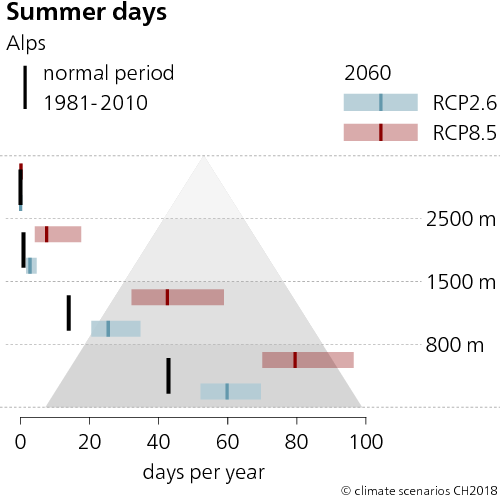Elevations in the Alps above 1,500 m a.s.l. experience very few summer days in today’s climate. This will change if greenhouse gas emissions continue to rise at current rates. In such a scenario, the number of frost days and days with fresh snowfall will probably decrease markedly.
The figures below illustrate the changes for four climate parameters at four elevations in the Alps. The altitude levels are shown in the right-hand half of the charts. The black vertical lines in the charts denote the current observed average (normal period of 1981 to 2010). The coloured bars indicate the possible range of the climate parameter in question for the two emission scenarios RCP2.6 and RCP8.5 during the period around 2060. The vertical coloured lines show the median value over the simulations with different climate models and represent the expected value.
What do RCP2.6 and RCP8.5 mean? You can find an explanation of the emission scenarios here.
Summer days now
In areas at elevations below 800 m a.s.l., there are around 40 summer days per year. Above 1,500 m a.s.l., summer days are very rare occurrences.
Summer days around 2060
Without climate change mitigation (RCP8.5), an average of 80 summer days per year are expected by mid-century in the inner Alpine valleys, and at elevations between 800 m a.s.l. and 1,500 m a.s.l., we can expect around 40 summer days. With climate change mitigation (RCP2.6), the number of summer days can be restricted to around 60 at the lowest elevations and to 25 in the mid-levels.
Tropical nights now
In the Alpine region, tropical nights are on average very rare over most of the elevation range.
Tropical nights around 2060
Without climate change mitigation (RCP8.5), the lowest-lying areas can expect several tropical nights a year. Above elevations of 1,500 m a.s.l., tropical nights will still be rare in the future. With climate change mitigation (RCP2.6), the number of tropical nights is expected to remain small, even in lower-lying Areas.
Frost days now
The lowest elevation record around 90 days of frost. Above 1,500 m a.s.l., more than half of the days in the year are currently frost days; above 2,500 m a.s.l., frost days occur for almost three-quarters of the year.
Frost days around 2060
Without climate change mitigation (RCP8.5), the low-lying areas can be expected to have an average of around 60 frost days per year by the middle of the century, whereas areas above 2,500 m a.s.l. will experience around 230 frost days per year. With climate change mitigation (RCP2.6), there would be around 75 frost nights at lower elevations and 250 at higher elevations.
Days with fresh snow now
At elevations above 1,500 m a.s.l., there are around 70 to 100 days in the year with fresh snowfall in the current climate. In the lowest-lying areas, there are currently 20 days of fresh snowfall per year on average.
Days with fresh snow around 2060
Without climate change mitigation (RCP8.5), the low-lying areas can be expected to have an average of around 12 days with fresh snowfall per year by the middle of the century, whereas areas above 2,500 m a.s.l. will experience around 75 fresh snowfall days per year. With mitigation (RCP2.6), there would still be some 15 days of fresh snowfall at lower elevations and 80 at higher elevations.
Last modification 11.12.2018









